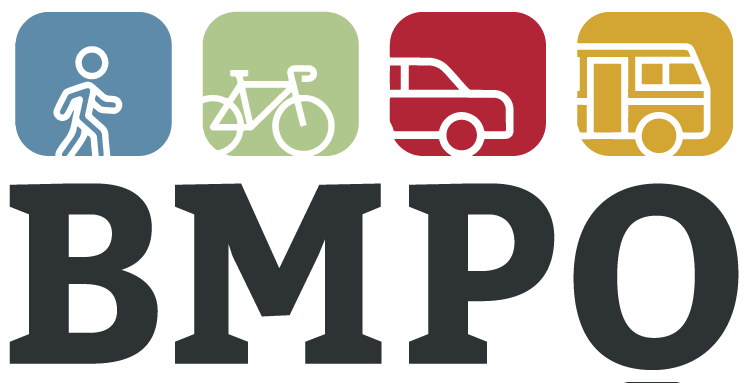
About BMPO
The Bonneville Metropolitan Planning Organization
Initiation
In compliance with federal regulations, the Bonneville Metropolitan Planning Organization (BMPO) was established in 1992 and is responsible for meeting the objectives and requirements of the federal “Fixing America’s Surface Transportation” or “FAST Act” in the Idaho Falls/Bonneville County metropolitan area.
Governance
BMPO is governed by a Policy Board comprised of elected officials or appropriate representatives from the Cities of Ammon, Idaho Falls, Iona and Ucon, Bonneville County, the Targhee Regional Public Transportation Authority (TRPTA) and the Idaho Transportation Department (ITD). The Board is a forum for cooperative transportation decision making and, with support from BMPO staff, Technical Advisory Committee (TAC) and public participation, is responsible for coordinating the local transportation planning process.
Metropolitan Planning Area
Under the 1990 Census, Idaho Falls and the surrounding area population exceeded 50,000 and was designated as an urbanized area. BMPO was established and required to accomplish the transportation planning process within the boundaries of the urbanized area as well as a much larger metropolitan planning area, as defined by the Policy Board, that reflects areas of future growth.
Transportation Planning Process
The transportation planning process requires that three documents be developed including a Unified Planning Work Program (UPWP), Transportation Improvement Program (TIP), and Long Range Transportation Plan (LRTP). Although not specifically required by federal regulations, BMPO generally funds and develops other necessary transportation planning documents such as a Short Range Transit Plan, Bicycle and Pedestrian Plan and various other transportation related studies or plans.
The following provides a brief explanation of these documents.
Unified Planning Work Program (UPWP)
Annual document that establishes the BMPO budget and federally funded transportation planning activities to be completed in the metropolitan planning area during the fiscal year.
Transportation Improvement Program (TIP)
Annual document that provides a programmed and prioritized list of federally funded transportation projects expected to be accomplished in the metropolitan planning area during the forthcoming five-year period.
Long Range Transportation Program (LRTP)
Twenty year multi-modal transportation plan that establishes new goals and objectives, describes transportation and financial conditions, identifies deficiencies and needs, prioritizes fundable projects and assesses potential impacts created from plan implementation. This plan is updated every five years.
Short Range Transit Plan (SRTP)
Five-year public transportation plan that establishes goals and objectives and identifies potential service improvements, capital projects and funding needs.
Bicycle and Pedestrian Plan
Five year document that outlines goals and objectives, identifies deficiencies and needs, recommends standards, and proposes a network for bicycle and pedestrian travel in the metropolitan planning area.
Other Studies or Plans
Upon request, transportation planning studies or plans may be performed that address existing and future traffic congestion, travel patterns, operations, safety concerns, etc. at specific roadways, intersections, developments, or other defined areas.
In order to perform the required or requested studies or plans, BMPO maintains or develops building permit data, current demographic data and projects, current traffic count data and projects, current accident data, traffic operational characteristics, public transportation statistics, and other relevant transportation data.
Funding
BMPO is primarily funded with federal dollars. However, a small match or contribution is required from the participating entities that comprise the BMPO. The UPWP identifies an annual estimate of funding amounts required from each of the participating entities.
Most of the funds spent on transportation projects identified in the LRTP and then prioritized by the Policy Board and programmed in the TIP come from federal transportation funding programs. However, the local sponsor of a transportation project is generally required to provide a small match amount that varies depending on federal program requirements. The TIP provides a detailed description of the various federal transportation funding programs.

